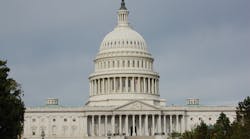Figuring out what the second Obama administration will prioritize in terms of transportation policy in the near term is top of mind for many industry experts at the moment, but dealing with the impending “fiscal cliff” is seen as the necessary first step by most.
“That’s the first domino that needs to fall,” Sean McNally, spokesman for the American Trucking Assns. (ATA), told Fleet Owner. “Until there’s certainty about tax rates and spending, it will make things much tougher especially in terms of economic recovery. The voters returned divided government to Washington so we’re hoping to see more bipartisanship in solving that major issue.”
Once the “fiscal cliff” is dealt with, transportation policy splits into two parts, according to McNally: regulatory initiatives directed by the U.S. Department of Transportation (DOT), much of which is contained within the MAP-21 highway bill signed into law back in July, and so-called “non-DOT” rulemaking efforts that pose a range of uncertainties for trucking.
Much of DOT’s policy initiatives are already spelled out in MAP-21, he said – such as a mandate for electronic onboard recorders (EOBRs) – and will go into effect no matter who had won the Presidential election. “We’re also likely to see more work on stability control regulations, EDRs [event data recorders], and truck crashworthiness studies,” McNally noted.
Other DOT efforts will continue to focus on minimum insurance levels for carriers, drug and alcohol test notification for employers, and efforts to eradicate the “reincarnation” of carriers shut down for safety reasons. “The question here boils down to how those issues are prioritized – and that really becomes a political question,” he said.
From trucking’s perspective, it’s “non-DOT” regulatory efforts that really cloud the crystal ball of transportation policy direction. “We’ve heard rumors that there may be efforts directed at driver pay, detention time, and driver health and wellness,” McNally pointed out. “We also expect continued focus on independent contractor classification as well.”
McNally also believes the Equal Employment Opportunity Commission (EEOC) will continue to examine carrier compliance with the Americans with Disability Act (ADA): an ongoing effort that’s already resulted in some highly controversial decisions, such as the EEOC’s lawsuit against LTL carrier Old Dominion Freight Line (ODFL) back in August 2011 for removing 5-year veteran truck driver from a permanent driving position who self-reported a problem with alcohol.
Yet overshadowing everything on the regulatory front is the issue of transportation funding. Barbara Harsha, spokesperson for the Governors Highway Safety Association (GHSA), stressed to Fleet Owner that MAP-21 currently funds a variety of highway safety and infrastructure programs through the end of fiscal year (FY) 2014 and so expects no major policy changes until that legislation expires.
“After that, the President and Congress have to agree on a plan to fund future improvements,” she said. “The President has said that he wants to support future infrastructure improvements with funds previously used to pay for two wars [but] the Congress is not likely to agree with this approach.”
The big question still remains the source of future funding, Harsha noted: Will it be through increased federal gasoline taxes, increased use of “general fund” monies, some combination of the two, or funding from some other source.
“At this point, it’s impossible to say how that will be resolved or whether that will involve more money for highway safety,” she added.
Harsha also pointed out that If Transportation Secretary Ray LaHood stays on, then there will be continued emphasis on distracted driving. However, if a new Secretary is appointed, he or she will have his/her own transportation and highway safety priorities.



